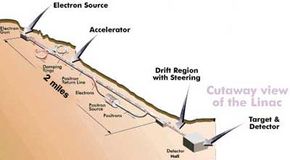Inside a Particle Accelerator
All particle accelerators, whether linacs or circular, have the following basic parts:
- Particle source - provides the particles that will be accelerated
- Copper tube - the particle beam travels in a vacuum inside this tube
- Klystrons - microwave generators that make the waves on which the particles ride
- Electromagnets (conventional, superconducting) - keep the particles confined to a narrow beam while they are travelling in the vacuum, and also steer the beam when necessary
- Targets - what the accelerated particles collide with
- Detectors - devices that look at the pieces and radiation thrown out from the collision
- Vacuum systems - remove air and dust from the tube of the accelerator
- Cooling systems - remove the heat generated by the magnets
- Computer/electronic systems - control the operation of the accelerator and analyze the data from the experiments
- Shielding - protects the operators, technicians and public from the radiation generated by the experiments
- Monitoring systems - closed-circuit television and radiation detectors to see what happens inside the accelerator (for safety purposes)
- Electrical power system - provides electricity for the entire device
- Storage rings - store particle beams temporarily when not in use
In the next sections, we will examine these parts in detail, focusing on a linear accelerator like the one at SLAC.
Advertisement
